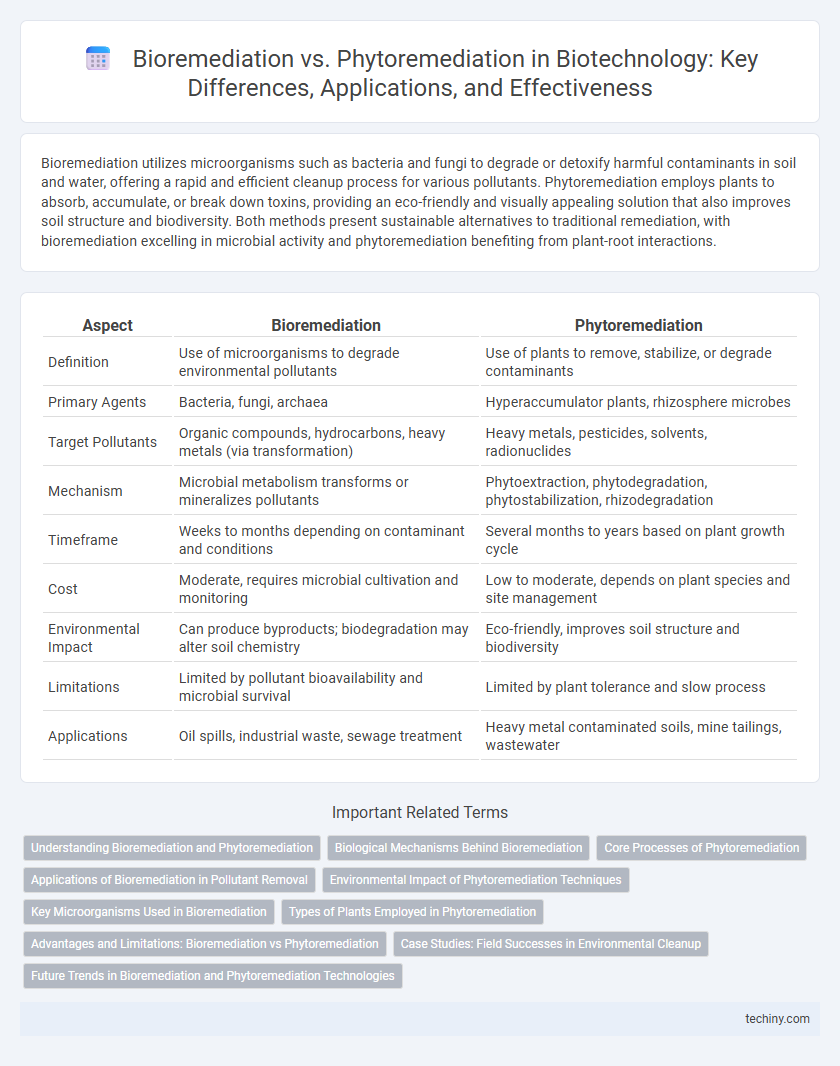Bioremediation utilizes microorganisms such as bacteria and fungi to degrade or detoxify harmful contaminants in soil and water, offering a rapid and efficient cleanup process for various pollutants. Phytoremediation employs plants to absorb, accumulate, or break down toxins, providing an eco-friendly and visually appealing solution that also improves soil structure and biodiversity. Both methods present sustainable alternatives to traditional remediation, with bioremediation excelling in microbial activity and phytoremediation benefiting from plant-root interactions.
Table of Comparison
| Aspect | Bioremediation | Phytoremediation |
|---|---|---|
| Definition | Use of microorganisms to degrade environmental pollutants | Use of plants to remove, stabilize, or degrade contaminants |
| Primary Agents | Bacteria, fungi, archaea | Hyperaccumulator plants, rhizosphere microbes |
| Target Pollutants | Organic compounds, hydrocarbons, heavy metals (via transformation) | Heavy metals, pesticides, solvents, radionuclides |
| Mechanism | Microbial metabolism transforms or mineralizes pollutants | Phytoextraction, phytodegradation, phytostabilization, rhizodegradation |
| Timeframe | Weeks to months depending on contaminant and conditions | Several months to years based on plant growth cycle |
| Cost | Moderate, requires microbial cultivation and monitoring | Low to moderate, depends on plant species and site management |
| Environmental Impact | Can produce byproducts; biodegradation may alter soil chemistry | Eco-friendly, improves soil structure and biodiversity |
| Limitations | Limited by pollutant bioavailability and microbial survival | Limited by plant tolerance and slow process |
| Applications | Oil spills, industrial waste, sewage treatment | Heavy metal contaminated soils, mine tailings, wastewater |
Understanding Bioremediation and Phytoremediation
Bioremediation utilizes microorganisms such as bacteria and fungi to degrade or detoxify environmental contaminants, making it effective for treating polluted soils and water. Phytoremediation employs specific plants to absorb, accumulate, or detoxify pollutants like heavy metals and organic compounds directly from the environment. Both methods harness natural biological processes, yet bioremediation primarily targets microbial metabolic pathways, while phytoremediation relies on plant physiology and root interactions.
Biological Mechanisms Behind Bioremediation
Bioremediation leverages microorganisms such as bacteria and fungi to degrade, transform, or immobilize pollutants through enzymatic reactions and metabolic pathways, effectively breaking down organic contaminants like hydrocarbons and heavy metals. These microbes utilize processes like aerobic respiration and anaerobic digestion to metabolize toxic substances into less harmful compounds, enhancing soil and water quality. The efficiency of bioremediation depends on microbial diversity, environmental conditions, and presence of nutrients that facilitate microbial growth and enzymatic activity.
Core Processes of Phytoremediation
Phytoremediation utilizes plants to absorb, degrade, or immobilize contaminants from soil and water through processes such as phytoextraction, phytodegradation, phytostabilization, and rhizofiltration. Core mechanisms involve root uptake of heavy metals, enzymatic breakdown of organic pollutants within plant tissues, and secretion of enzymes that stimulate microbial degradation in the rhizosphere. This process offers eco-friendly remediation by harnessing natural plant metabolic pathways for pollutant removal, contrasting with microbial-based bioremediation techniques.
Applications of Bioremediation in Pollutant Removal
Bioremediation utilizes microorganisms to degrade hazardous contaminants in soil, water, and air, effectively removing petroleum hydrocarbons, heavy metals, and pesticides from polluted sites. Its applications include treatment of oil spills, industrial effluents, and groundwater contamination, making it a cost-effective and eco-friendly method for environmental cleanup. Enzymatic activity and microbial metabolism play crucial roles in transforming toxic substances into less harmful compounds, enhancing pollutant removal efficiency.
Environmental Impact of Phytoremediation Techniques
Phytoremediation techniques leverage plants to absorb, degrade, or immobilize contaminants, offering a sustainable and eco-friendly alternative to traditional bioremediation methods that often rely on microbial action. The environmental impact of phytoremediation is generally positive, as it enhances soil health, reduces toxic waste, and promotes biodiversity without introducing harmful chemicals. However, careful selection of plant species and monitoring is essential to prevent potential issues such as bioaccumulation of toxins in the food chain or invasive species proliferation.
Key Microorganisms Used in Bioremediation
Key microorganisms used in bioremediation include bacteria such as Pseudomonas, Bacillus, and Rhodococcus, which degrade hydrocarbons and toxic pollutants. Fungi like white-rot fungi (Phanerochaete chrysosporium) play a crucial role in breaking down complex organic compounds through enzymatic action. These microbes enhance contaminant removal efficiency, distinguishing bioremediation from phytoremediation, which relies primarily on plants for pollutant uptake and stabilization.
Types of Plants Employed in Phytoremediation
Phytoremediation employs hyperaccumulator plants such as Indian mustard (Brassica juncea) and sunflowers (Helianthus annuus) to extract heavy metals from contaminated soils. Aquatic plants like water hyacinth (Eichhornia crassipes) and duckweed (Lemna minor) are used for removing pollutants from wastewater. These plants facilitate pollutant absorption, degradation, or stabilization, making them essential biological tools for environmental cleanup.
Advantages and Limitations: Bioremediation vs Phytoremediation
Bioremediation utilizes microorganisms to degrade hazardous contaminants, offering rapid treatment and versatility across diverse pollutants, but it may require controlled environmental conditions and extended periods for complete remediation. Phytoremediation employs plants to extract, stabilize, or degrade pollutants, providing a cost-effective and eco-friendly approach with aesthetic benefits, though its efficiency is limited by contaminant bioavailability and slower processing rates. Both methods complement each other in biotechnological applications, with bioremediation excelling in microbial metabolism and phytoremediation providing sustainable remediation for soil and water ecosystems.
Case Studies: Field Successes in Environmental Cleanup
Case studies highlight bioremediation's effectiveness in degrading petroleum hydrocarbons in oil spill sites using microbial consortia, achieving significant pollutant reduction within months. Phytoremediation demonstrates success in heavy metal-contaminated soils through hyperaccumulator plants like Indian mustard and poplar trees, showing biomass-based contaminant extraction in mining-affected areas. Both techniques illustrate scalable, eco-friendly solutions for restoring polluted environments with site-specific optimization enhancing cleanup efficiency.
Future Trends in Bioremediation and Phytoremediation Technologies
Future trends in bioremediation emphasize the integration of advanced genetic engineering and microbial consortia to enhance pollutant degradation efficiency and specificity. Phytoremediation technologies are increasingly leveraging transgenic plants and rhizosphere microbiome engineering to improve heavy metal uptake and organic contaminant breakdown. Both approaches benefit from developments in omics technologies and bioinformatics, enabling real-time monitoring and optimization for sustainable environmental remediation.
Bioremediation vs Phytoremediation Infographic

 techiny.com
techiny.com